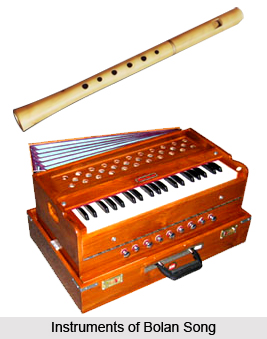 Bolan Song is a popular folk drama of South Bengal. It is a type of party music requiring a large number of participants like a Jatra group. The song is connected with Puja of Lord Shiva held during the last day of Chaitra. Actually, this musical performance is an extension from Gajan festival and Gambhira of Maldah. Acting, songs, dance and dialogue are the integral part of Bolan.
Bolan Song is a popular folk drama of South Bengal. It is a type of party music requiring a large number of participants like a Jatra group. The song is connected with Puja of Lord Shiva held during the last day of Chaitra. Actually, this musical performance is an extension from Gajan festival and Gambhira of Maldah. Acting, songs, dance and dialogue are the integral part of Bolan.
Meaning of Bolan
Different scholars and artists have defined the term differently. As per Gurusaday Dutta, the word "Bolan" means a ballad dance. He opined that the word Bolan means recitation and the dance derives its name from the fact that one of the dancers recites the ballad from a writing which he holds in his hand while performing. According to Anchanan Mondal, `Bol" which means "sound" is the original word of Bolan. As per Folk Etymology, the term "Bula" means "to walk or travel. While Shri Pulakendu Sinha has observed that Bolan is a "play" composed in poetical form. The form contains a metrical system of Bengali poetry where each line consists of fourteen letters or syllables.
History of Bolan Song
The root of Bolan Song is at Nadia district of south Bengal. However, with time this folk drama has spread through Bardwan, Birbhum and Murshidabad. The main areas where Bolan is practiced are Kaligang, Palashipara, Paglachandi, Tehatta, Debogram, Krishnaganj etc., at Nadia district. Lavpur and Nanur in Birbhum, Kandi, Bharatpur at Murshidabad and Katoya, Ketugram in Burdwan are some other places where it is performed.
Subjects of Bolan Song
The subject matter of Bolan songs is of miscellaneous types collected from popular episodes like Radha-Lord Krishna relations (Naukabilas, Manbhanjan, etc.), Sabitri-Satyaban, Kama, Harishchandra, Sita, Lava-Kusha and so on. Music is generally rendered in Pancali form, and some of the participants are presented on the stage as female performers. They render music, Tappa and Pancali form of narratives with human touches for hours.
However, the themes of these songs have expanded their wings to include social and contemporary issues. Now through performance, it imparts education and presents social awareness among the people as well.
Performance of Bolan Song
In the earlier days, the performers moved from one village to another and perhaps this wandering later identified this folk drama as Bolan. Traditionally, Bolan drama was performed only at "Gajan Utsav". But now a day, it is performed in different times of a year. The performers decorate themselves with dresses and costumes like Saree, Blause, half-pant, Lungi, Photuya etc.
Musical Instruments of Bolan Song
The various musical instruments that mainly accompany Bolan Song comprise of harmonium, flute, and violin. Sometimes other modern percussion instruments like dholak and judi are also used.
Modifications of Bolan Song
Over the years, this performing art has undergone many modifications. The modifications mainly focussed on the lighting, costumes, acting, musical instruments, musical tunes and the story of this drama.




















